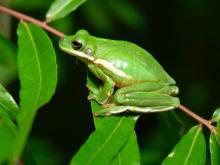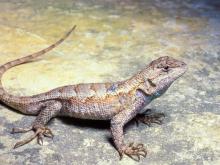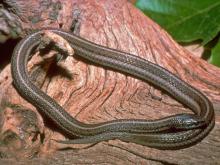Reptiles and Amphibians
Media

Species Types
Scientific Name
Hyla cinerea (syn. Dryophytes cinereus)
Description
The bright green treefrog hides perfectly among cattail leaves, where it rests until evening. Then it begins hunting for insects. In Missouri, it occurs mostly in the Bootheel.
Media

Species Types
Scientific Name
Sceloporus consobrinus
Description
The prairie lizard is a small, gray to brown, rough-scaled lizard common in open forests. It often lives around country homes and rock gardens and on stacks of firewood and split rail fences.
Media

Species Types
Scientific Name
Thamnophis sirtalis sirtalis (eastern gartersnake) and T. s. parietalis (red-sided gartersnake)
Description
The eastern gartersnake and red-sided gartersnake are Missouri's most common gartersnakes. The color is variable, but there are normally three yellowish stripes, one down the back and one on each side. There are narrow black bars between the scales along the upper lip.
Media

Species Types
Scientific Name
Plestiodon fasciatus
Description
The common five-lined skink is one of Missouri's most abundant skinks. Adults are olive or tan with lengthwise stripes. It is often called the blue-tailed skink for the coloration of juveniles. Occurs nearly statewide.
Media

Species Types
Scientific Name
Plestiodon laticeps
Description
The broad-headed skink is a large, smooth-scaled lizard that lives in the southern two-thirds of Missouri. It is frequently confused with the common five-lined skink, which is smaller.
Media

Species Types
Scientific Name
Storeria dekayi
Description
Dekay's brownsnake is a small, secretive species that prefers moist environments. It can be gray to brown to reddish brown. It usually has a tan stripe running down the back, bordered by two rows of small brown spots. The top of the head is usually dark. Occurs statewide.
Media

Species Types
Scientific Name
Pantherophis obsoletus
Description
The western ratsnake, a glossy black snake, is one of Missouri’s largest and most familiar snakes. Its size and dark color make it seem imposing, but it is as harmless to humans as it is bad news for rodents.
Media

Species Types
Scientific Name
Tropidoclonion lineatum
Description
The lined snake looks similar to a gartersnake. It is brown to grayish brown, with three lighter-colored stripes down the length of its body and a double row of half-moon-shaped markings along the belly. It occurs mainly in the northwestern part of the state, along the northern border, with a separate population in the St. Louis area.
Media

Species Types
Scientific Name
Ambystoma annulatum
Description
The ringed salamander is secretive, spending most of its time under logs or rocks or in burrows. The rings never completely encircle the body. It occurs in the southwestern and central Missouri Ozarks, and in the river hills of the Missouri River in eastern Missouri.
Media

Species Types
Scientific Name
Ambystoma maculatum
Description
The spotted salamander is one of Missouri's six species of mole salamanders. It is slate black with two irregular rows of rounded yellow spots from the head onto the tail. It occurs in forests in the southern two-thirds of the state.
See Also
About Reptiles and Amphibians in Missouri
Missouri’s herptiles comprise 43 amphibians and 75 reptiles. Amphibians, including salamanders, toads, and frogs, are vertebrate animals that spend at least part of their life cycle in water. They usually have moist skin, lack scales or claws, and are ectothermal (cold-blooded), so they do not produce their own body heat the way birds and mammals do. Reptiles, including turtles, lizards, and snakes, are also vertebrates, and most are ectothermal, but unlike amphibians, reptiles have dry skin with scales, the ones with legs have claws, and they do not have to live part of their lives in water.





















